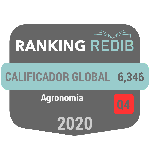Atividade antimicrobiana do óleo essencial de Cymbopogon schoenanthus extraído por um sistema de destilação solar
Resumo
O Cymbopogon schoenanthus (L.) Spreng é uma planta medicinal aromática que cresce na Argélia. É vulgarmente chamada erva de camelo e conhecida pelo nome local “Lemmad”. Tradicionalmente, tem sido utilizada para tratar diversas doenças. Por conseguinte, este estudo teve como objetivo avaliar a atividade antimicrobiana do óleo essencial de Cymbopogon schoenanthus (EOCS), cultivado em Timiaouine, na Argélia, Foi utilizado um sistema de destilação solar (DS). Esta extração teve lugar em junho de 2023. Posteriormente, foram determinadas as propriedades físicas. A atividade antimicrobiana contra quatro bactérias e uma levedura foi avaliada utilizando o teste de difusão em ágar. Foram utilizadas várias diluições e as zonas de inibição foram medidas para determinar a extensão da atividade antimicrobiana. Neste estudo, o rendimento foi estimado em 0,97 %, com uma densidade de 0,8490 e um índice de refração de 1,4850. As propriedades antimicrobianas deste óleo essencial (OE) mostraram eficácia contra Escherichia coli (EC) e Klebsiella pneumoniae (KP) em diluições de 1/3 e 1/4, com diâmetros de inibição variando de 15 a 9 mm. Por outro lado, outras cepas apresentaram resistência em todas as diluições. Esta investigação indica que o EOCS extraído através do processo SD tem propriedades antibacterianas eficazes contra bactérias Gram-. Além disso, é necessária investigação adicional para clarificar e avaliar os efeitos da composição química, melhorando assim a nossa compreensão do mecanismo subjacente.
Downloads
Referências
Al-Hilphy, A. R., Ahmed, A. K., Gavahian, M., Chen, H., Chemat, F., Al‐Behadli, T. M., Mohd Nor, M. Z., & Ahmad, S. (2022). Solar energy‐based extraction of essential oils from cloves, cinnamon, orange, lemon, eucalyptus, and cardamom: A clean energy technology for green extraction. Journal of Food Process Engineering, 45(6), e14038. https://doi.org/10.1111/jfpe.14038
Aous, W., Benchabane, O., Outaleb, T., Hazzit, M., Mouhouche, F., Yekkour, A., & Baaliouamer, A. (2019). Essential oils of Cymbopogon schoenanthus (L.) Spreng. from Algerian Sahara: Chemical variability, antioxidant, antimicrobial and insecticidal properties. Journal of Essential Oil Research, 31(6), 562-572. https://doi.org/10.1080/10412905.2019.1612790
International Organization for Standardization [ISO]. (1998). ISO 279:1998: Essential oils - Determination of relative density at 20 °C - Reference method (2nd ed.). https://cdn.standards.iteh.ai/samples/25308/17ce247df4814c8ba147d3e9f8f711ff/ISO-279-1998.pdf
Bakkali, F., Averbeck, S., Averbeck, D., & Idaomar, M. (2008). Biological effects of essential oils - A review. Food and Chemical Toxicology, 46(2), 446-475. https://doi.org/10.1016/j.fct.2007.09.106
Bellik, F. Z., Benkaci-Ali, F., Alsafra, Z., Eppe, G., Tata, S., Sabaou, N., & Zidani, R. (2019). Chemical composition, kinetic study and antimicrobial activity of essential oils from Cymbopogon schoenanthus L. Spreng extracted by conventional and microwave-assisted techniques using cryogenic grinding. Industrial Crops and Products, 139, 111505. https://doi.org/10.1016/j.indcrop.2019.111505
Boukhalfa, Djamel, Yaha, Nour & Nabti, Bachir. (2023). Phytochemical analysis and biological activity of the essential oil of lemongrass (Cymbopogon schoenanthus (L.) Spreng) from the Algerian Sahara. GSC Biological and Pharmaceutical Sciences, 22, 114-122. https://doi.org/10.30574/gscbps.2023.22.3.0103
Boutabia, L., Telailia, S., Bouguetof, I., Guenadil, F., & Chefrour, A. (2016). Composition chimique et activité antibactérienne des huile essentielles de Rosmarinus officinalis L.de la région de Hammamet (Tébessa-Algérie). Bulletin de la Société Royale des Sciences de Liège, 85, 174-189. https://doi.org/10.25518/0037-9565.6050
Clinical and Laboratory Standards Institute (Eds.). & Cockerill, F. R. [CLSI] (2012). Performance standards for antimicrobial susceptibility tests: Approved standard - eleventh edition.
Deans, S. G., & Ritchie, G. (1987). Antibacterial properties of plant essential oils. International Journal of Food Microbiology, 5(2), 165-180. https://doi.org/10.1016/0168-1605(87)90034-1
Dhifi, W., Bellili, S., Jazi, S., Bahloul, N., & Mnif, W. (2016). Essential oils’ chemical characterization and investigation of some biological activities: A critical review. Medicines, 3(4), 25. https://doi.org/10.3390/medicines3040025
Dorman, H. J. D., & Deans, S. G. (2000). Antimicrobial agents from plants: Antibacterial activity of plant volatile oils. Journal of Applied Microbiology, 88(2), 308-316. https://doi.org/10.1046/j.1365-2672.2000.00969.x
Ekor, M. (2014). The growing use of herbal medicines: issues relating to adverse reactions and challenges in monitoring safety. Frontiers in Pharmacology, 4. https://doi.org/10.3389/fphar.2013.00177
Halla, N., Boucherit, K., Zeragui, B., Djelti, A., Belkhedim, Z., Hassani, R., Benatallah, S., Djellouli, H., Kacimi, O., & Boucherit-Otmani, Z. (2020). Polyphenols content and antimicrobial, antioxidant and hemolytic activities of essential oils from four selected medicinal plants growing in Algeria. Biology Medicine Natural Product Chemistry, 9(2), 65-75. https://doi.org/10.14421/biomedich.2020.92.65-75
Hashim, G. M., Almasaudi, S. B., Azhar, E., Al Jaouni, S. K., & Harakeh, S. (2017). Biological activity of Cymbopogon schoenanthus essential oil. Saudi Journal of Biological Sciences, 24(7), 1458-1464. https://doi.org/10.1016/j.sjbs.2016.06.001
Heiba, H.I., & Rizk, A.M. (1986). Constituents of Cymbopogon species. Qatar University Science Journal, 6, 53–75. https://qspace.qu.edu.qa/bitstream/handle/10576/9817/Constituents%20of%20cymbopogon%20species.pdf
Kalemba, D., & Kunicka, A. (2003). Antibacterial and antifungal properties of essential oils. Current Medicinal Chemistry, 10(10), 813–829. https://doi.org/10.2174/0929867033457719
Karakaya, S., El, S. N., Karagozlu, N., Sahin, S., Sumnu, G., & Bayramoglu, B. (2014). Microwave-assisted hydrodistillation of essential oil from rosemary. Journal of Food Science and Technology, 51(6), 1056-1065. https://doi.org/10.1007/s13197-011-0610-y
Katiki, L. M., Chagas, A. C. S., Bizzo, H. R., Ferreira, J. F. S., & Amarante, A. F. T. (2011). Anthelmintic activity of Cymbopogon martinii, Cymbopogon schoenanthus and Mentha piperita essential oils evaluated in four different in vitro tests. Veterinary Parasitology, 183, (1-2), 103-108. https://doi.org/10.1016/j.vetpar.2011.07.001.
Khadri, A., Serralheiro, M. L. M., Nogueira, J. M. F., Neffati, M., Smiti, S., & Araújo, M. E. M. (2008). Antioxidant and antiacetylcholinesterase activities of essential oils from Cymbopogon schoenanthus L. Spreng. Determination of chemical composition by GC-mass spectrometry and 13C NMR. Food Chemistry, 109(3), 630-637. https://doi.org/10.1016/j.foodchem.2007.12.070
Kpoviessi, S., Bero, J., Agbani, P., Gbaguidi, F., Kpadonou-Kpoviessi, B., Sinsin, B., Accrombessi, G., Frédérich, M., Moudachirou, M., & Quetin-Leclercq, J. (2014). Chemical composition, cytotoxicity and in vitro antitrypanosomal and antiplasmodial activity of the essential oils of four Cymbopogon species from Benin. Journal of Ethnopharmacology, 151(1), 652-659. https://doi.org/10.1016/j.jep.2013.11.027
Lukose, R., Kalbande, S. R., & John, J. (2023). Utilisation of solar energy for essential oil extraction: An overview. International Journal of Ambient Energy, 44(1), 1151-1165. https://doi.org/10.1080/01430750.2022.2163688
Mahboub Nasma, Slimani, Noureddine and Henni, Meriem. (2019). Extraction and characterization of the antioxidant activity of essential oils from Cotula cinerea in the region of El Oued (Algeria). International Journal of Biological and Agricultral Reasearch, 2(1), 14-23.
https://dspace.univ-eloued.dz/items/c553323d-8ca5-4390-b129-0dc4fbcb2eeb
Malti, C. E. W., El Haci, I. A., Hassani, F., Paoli, M., Gibernau, M., Tomi, F., Casanova, J., & Bekhechi, C. (2020). Composition, chemical variability and biological activity of Cymbopogon schoenanthus essential oil from Central Algeria. Chemistry & Biodiversity, 17(6), e2000138. https://doi.org/10.1002/cbdv.202000138
Mc Gaw, D., & Skeene, R. (2021). Comparison of the sub-critical fluid extraction of the essential oil of turmeric (Curcuma longa L.) with that of hydrodistillation. Eng, 2(4), 608-619. https://doi.org/10.3390/eng2040038
Munir, A., Hensel, O., Scheffler, W., Hoedt, H., Amjad, W., & Ghafoor, A. (2014). Design, development and experimental results of a solar distillery for the essential oils extraction from medicinal and aromatic plants. Solar Energy, 108, 548-559. https://doi.org/10.1016/j.solener.2014.07.028
Naima, H., Mahfoud, H. M., Farah, R., & Alia, T. (2016). Antimicrobial and antioxidant activities of Cymbopogon schoenanthus (L.) Spreng. Essential oil, growing in Illizi-Algeria. Journal of Medicinal Plants Research, 10(14), 188-194. https://doi.org/10.5897/JMPR2015.5985
Nannaware, A. D., Sai Kumar, C. M., Srivastava, S., Singh, S., Gupta, M. K., Rout, P. K., Chanotiya, C. S., Lal, R. K., Nimdeo, Y., & Roy, S. (2022). Eco-friendly solar distillation apparatus for improving the yield of essential oils with enhancing organoleptic characteristics. Renewable Energy, 191, 345-356. https://doi.org/10.1016/j.renene.2022.03.147
Park, S. E., Shin, W. T., Park, C., Hong, S. H., Kim, G.-Y., Kim, S. O., Ryu, C. H., Hong, S. H., & Choi, Y. H. (2014). Induction of apoptosis in MDA-MB-231 human breast carcinoma cells with an ethanol extract of Cyperus rotundus L. by activating caspases. Oncology Reports, 32(6), 2461-2470. https://doi.org/10.3892/or.2014.3507
Pavlović, I., Omar, E., Drobac, M., Radenkovic, M., Brankovic, S., & Kovacevic, N. (2017). Chemical composition and spasmolytic activity of Cymbopogon schoenanthus (L.) Spreng. (Poaceae) essential oil from Sudan. Archives of Biological Sciences, 69(3), 409-415. https://doi.org/10.2298/ABS160506113P
Ponce, A. G., Fritz, R., Del Valle, C., & Roura, S. I. (2003). Antimicrobial activity of essential oils on the native microflora of organic Swiss chard. LWT - Food Science and Technology, 36(7), 679–684. https://doi.org/10.1016/S0023-6438(03)00088-4
Quézel, P., & Santa, S. (1962). Nouvelle flore de l’algérie et de ses régions désertiques méridionales. Tome i. Paris, editions du centre national de la recherche scientifique, 1962. Revue d’Écologie (La Terre et La Vie), 18(2), 82-86.
Reichling, J., Schnitzler, P., Suschke, U., & Saller, R. (2009). Essential oils of aromatic plants with antibacterial, antifungal, antiviral, and cytotoxic properties - an overview. Complementary Medicine Research, 16(2), 79-90. https://doi.org/10.1159/000207196
Sawadogo, I., Paré, A., Kaboré, D., Montet, D., Durand, N., Bouajila, J., Zida, E. P., Sawadogo-Lingani, H., Nikiéma, P. A., Nebié, R. H. C., & Bassolé, I. H. N. (2022). Antifungal and antiaflatoxinogenic effects of Cymbopogon citratus, Cymbopogon nardus, and Cymbopogon schoenanthus essential oils alone and in combination. Journal of Fungi, 8(2), 117. https://doi.org/10.3390/jof8020117
Sellami, I. H., Maamouri, E., Chahed, T., Wannes, W. A., Kchouk, M. E., & Marzouk, B. (2009). Effect of growth stage on the content and composition of the essential oil and phenolic fraction of sweet marjoram (Origanum majorana L.). Industrial Crops and Products, 30(3), 395-402. https://doi.org/10.1016/j.indcrop.2009.07.010
Shaaban, H. A. E., El-Ghorab, A. H., & Shibamoto, T. (2012). Bioactivity of essential oils and their volatile aroma components: Review. Journal Essential Oil Research, 24(2), 203-212. https://doi.org/10.1080/10412905.2012.659528
Verma, R. S., Padalia, R. C., & Chauhan, A. (2013). Introduction of Cymbopogon distans (Nees ex Steud.) Wats to the sub-tropical India: Evaluation of essential-oil yield and chemical composition during annual growth. Industrial Crops and Products, 49, 858–863. https://doi.org/10.1016/j.indcrop.2013.06.025
Wojdylo, A., Oszmianski, J., & Czemerys, R. (2007). Antioxidant activity and phenolic compounds in 32 selected herbs. Food Chemistry, 105(3), 940 949. https://doi.org/10.1016/j.foodchem.2007.04.038
Yagi, S., Babiker, R., Tzanova, T., & Schohn, H. (2016). Chemical composition, antiproliferative, antioxidant and antibacterial activities of essential oils from aromatic plants growing in Sudan. Asian Pacific Journal Tropical Medicine, 9(8), 763-770. https://doi.org/10.1016/j.apjtm.2016.06.009
Yen, H. Y., & Lin, Y. C. (2017). Green extraction of Cymbopogon citrus essential oil by solar energy. Industrial Crops and Products, 108, 716-721. https://doi.org/10.1016/j.indcrop.2017.07.039
Direitos de Autor (c) 2025 Zineb Safa, Ahmed Boulal, Khawla Zahra Hadef, Katia Djenadi

This work is licensed under a Creative Commons Attribution-NonCommercial-ShareAlike 4.0 International License.

















